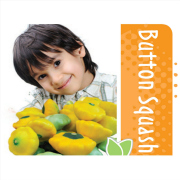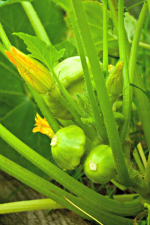Button squash or ‘patty pan squash’ are small fruit that look a bit like space ships with scalloped edges. They grow to between 7 and 10cm in diameter and although they are available in other colours, the most common are the pale green and the bright yellow ones. The flesh is pale white and the whole squash is eaten cooked, including the skin and seeds.
PLANTING
Choose a spot in the garden where there is lots of space and that gets at least 6 hours of sun every day. Prepare the garden bed by removing any weeds and digging some compost into the topsoil. Use a dibbler or big stick to make small holes about 60cm apart and gently place one seedling into each one, pushing the soil around the roots. Water the seedlings lightly.
Button squash are easy to grow in large containers such as barrels or tubs. Fill the containers with premium potting mix and water it lightly. Place two seedlings in each container and make sure there is room for the vines to spill over the edge. The vine will also grow over a trellis or fence if one is available.
CARE AND MAINTENANCE
Button squash like to have the soil kept moist so give them some water every day. If lots of compost was added when they were first planted, they may not need any fertiliser but if the leaves start to go a little yellow, feed them with liquid fertiliser or composted manure. If there’s not much space on the ground, build a strong trellis for the vine to grow over.
HARVESTING
Summer squash such as these should be picked when under-ripe because those that are left on the vine too long become very tough. Start picking the fruit as soon as it is between 5 and 10cm in diameter and this will also encourage new squash to grow. Store them unwashed in a plastic bag in the fridge.
HOW TO EAT
Button squash is very easy to cook in the microwave by cutting each one in half and cooking on high for 2 minutes. They can also be baked or steamed whole and are delicious sliced in stir-fries. Very young squash with the flower still attached can be steamed and served with just a little butter. They look fantastic and taste great as well.
There are lots of recipes for button squash in the Smarty Plants Kitchen.
HOW THEY GROW
Button squashes are related to zucchini, pumpkins and melons and just like these they grow on a vine with large leaves which shade their fruit from the hot sun. The vine will trail across the ground or climb a trellis if one is available.
FAST FACTS
Botanical Name: Cucurbita pepo
Life Cycle: Annual
When to Grow: Spring, summer and autumn
Height/Width: The vine can spread to cover an area of around 60cm x 60cm and 40cm high.
Requirements: Plant in full sun and water every day.
Nutritional Benefits: Button squash are a great source of vitamin C.




